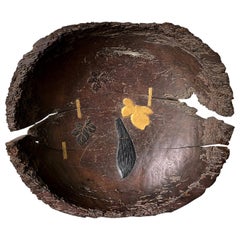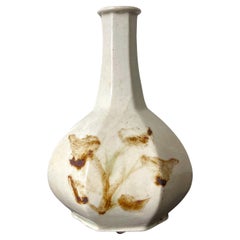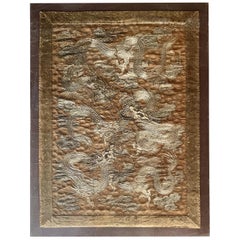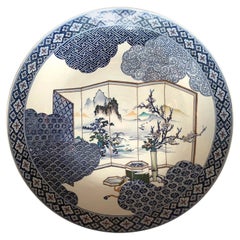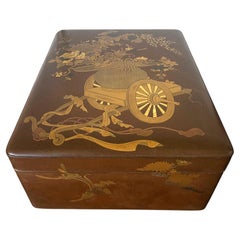TISHU Furniture
to
6
337
337
5
3
1
155
337
638
108
171
209
188
26
4
14
18
32
49
46
68
35
30
198
95
74
68
59
321
300
124
92
74
337
337
337
9
5
4
2
1
Period: 19th Century
Antique Japanese Lacquered Wood Wabi-Sabi Bowl
Located in Atlanta, GA
What can we say about this bowl? Perhaps we can start by describing the unique Japanese aesthetic concept of "Wabi-Sabi". In contrast to the western concept of beauty that is centere...
Category
Antique 19th Century Japanese Japonisme Lacquer
Materials
Wood
Korean Ceramic Faceted Wine Bottle Vase Joseon Dynasty
Located in Atlanta, GA
A Korean ceramic bottle with octagonal faceted form with underglaze copper red decoration. The robust bottle with the long neck and a relatively thick built was used to hold liquor such as wine and it was from Joseon dynasty, likely late period (circa mid-late 19th century). The bottle was covered in a milky white glaze with a pleasant warm yellow tint. It has an underglaze iron red paint of branches of gingko leaves on the front and the back side. The color was oxidated into an ochre brown hue instead of iron red. The octagonal form extends nicely from the opening to the base, continuing through the body and makes this bottle geometrically interesting. The rustic paint of the gingko leaves also render the piece a folky modern appeal.
For three faceted wine bottles from different period of Joseon Dynasty, see illustration 2, 71 and 73 of "Five Centuries of Korean Ceramics Pottery and Porcelains of the Yi Dynasty...
Category
Antique 19th Century Korean Archaistic Ceramics
Materials
Ceramic
Large Framed Japanese Embroidery Dragon Tapestry
Located in Atlanta, GA
An impressive Japanese embroidery tapestry circa 1890s Meiji period, presented with brocade border on linen canvas in a Lucite shadow box. The stunning design features three dragons coiling and flying in the clouds. The high relief technique used to render the dragons using mostly the silver threads gives this piece a tremendous sense of motion. The most auspicious mythological creature in Japan and China, dragons were a very popular motif in textile art. In this particular piece, it is the impressive size, the superb craftsmanship, the profuse use of silver threads and near perfect condition that set it apart. Japanese Meiji textiles were widely exhibited in the west during turn of the 20th century at the international exposition. It was used to showcase the Japanese aesthetics with the techniques at their pinnacle. These expositions solidified the country's images overseas and felled the Japanese craze in the west, which turned out to be a long-lasting influence on the western art. Many pieces were purchased and stayed in the west. It is likely this estate piece was from one of the expositions based on its high quality.
For two similar dragon tapestries...
Category
Antique 1890s Japanese Japonisme Textiles
Materials
Textile, Lucite
Chinese Folding Floor Screen with Stone Insets
Located in Atlanta, GA
A six panel hinged folding floor screen from China circa end of the 19th- early 20th century. Each panel features three sections of black lacquere...
Category
Antique Late 19th Century Chinese Chinese Export Furniture
Materials
Stone
Massive Japanese Arita Presentation Porcelain Plate Meiji Period
Located in Atlanta, GA
This massive Japanese Arita plate was made in Hizen, circa 1890-1910s, at the end of Meiji period by a potter named Takeshige Yoshisuke who was active in A...
Category
Antique Late 19th Century Japanese Japonisme Ceramics
Japanese Lacquer Ryoshibako Document Box Meiji Period
Located in Atlanta, GA
A large Japanese lacquer box with elaborate Maki-e design from Meiji period, (mid-late 19th century). The generous size of the box was reser...
Category
Antique 19th Century Japanese Japonisme Lacquer
Materials
Wood, Lacquer
Framed Antique Japanese Embroidery Fukusa Panel
Located in Atlanta, GA
A finely embroidered Japanese silk Fukusa panel presented in a beautiful silk-lined giltwood frame (newly framed and glazed), circa late 19th century of Meiji Period. Fukusa is a tra...
Category
Antique Late 19th Century Japanese Meiji Textiles
Materials
Silk, Wood
Framed Antique Japanese Embroidery Fukusa Panel Takasago Legend
Located in Atlanta, GA
A finely embroidered Japanese silk Fukusa panel presented in a beautiful silk-lined giltwood frame (newly framed and glazed), circa late 19th century of Meiji Period. Fukusa is a traditional Japanese textile art used to wrap and present gifts at important occasions. Depending on the occasion, the panel itself can be a very fine textile art on its own.
On the deep blue background, this elaborate textile art depicts an old couple standing on a bridge with three bystanders, flanked by pine trees with hills afar. The couple is Jotomba (Joo and Uba are their respective names), characters in the Legend of Takasago, one of the oldest Japanese mythologies, who are associated with old pines. The legend goes as: "At Takasago Shrine there is a very old pine tree, the trunk of which is bifurcated; in it dwells the spirit of the Maiden of Takasago who was seen once by the son of Izanagi who fell in love and wedded her. Both lived to a very great age, dying at the same hour on the same day, and since then their spirits abide in the tree, but on moonlight nights they return to human shape to revisit the scene of their earthly felicity and pursue their work of gathering pine needles. His pine tree is called “The Pine of Suminoe” while hers is "Takasago pine".
In Japan, Takasago couple...
Category
Antique Late 19th Century Japanese Meiji Textiles
Materials
Silk, Wood
Framed Antique Japanese Embroidery Fukusa Textile Panel
Located in Atlanta, GA
A Japanese silk Fukusa Panel housed in a gilt frame circa late 19th century of Meiji Period. Fukusa is a traditional Japanese textile art used as a wrap for presenting gifts at important occasions. On the deep blue background, the elaborate embroidery work depicts three deities of the Shichifukujin (Seven Gods of Fortune...
Category
Antique Late 19th Century Japanese Meiji Textiles
Materials
Silk, Wood
Antique Spanish Colonial Statue Santo Madonna
Located in Atlanta, GA
A most spectacular antique Spanish Colonial figure of Madonna, Mexico circa 19th century possibly earlier. Constructed in plaster with carved and gilt wood accent. Realistic in style...
Category
Antique 19th Century Mexican Spanish Colonial Figurative Sculptures
Materials
Metal
Spanish Colonial Antique Santo Figure
Located in Atlanta, GA
A stunning antique parcel-giltwood statue of St. John, 19th century, possibly earlier, from Mexico, Spanish Colonial with polychrome paint decoration. St John was depicted as a regal...
Category
Antique 19th Century Mexican Spanish Colonial Figurative Sculptures
Materials
Gold Leaf
Important Miniature Japanese Bamboo Basket by Hayakawa Shokosai I
Located in Atlanta, GA
A miniature bamboo basket woven by Hayakawa Shokosai I (1815-1897) circa 1885, an important example of the work by the artist who is considered as the founding father of Japanese modern bamboo art and the first ever signed his own work thus elevating bamboo weaving from a craft into an art form. The miniature basket was traditionally used during Sencha tea ceremony. It was woven from bamboo (madake) and rattan using...
Category
Antique 1880s Japanese Japonisme Decorative Baskets
Materials
Bamboo, Rattan
A stack of six antique wood trays with bone inlays
Located in Atlanta, GA
A fantastic set of six antique trays that fit into a stack, likely from British India turn of the 20th century. The wood is likely rosewood with attractive grains and the trays are i...
Category
Antique 1890s Indian British Colonial Serving Pieces
Materials
Wood, Bone
Framed Antique Chinese Silk Robe with Dragon Roundel Design
Located in Atlanta, GA
A black silk robe with three medallions of five-clawed dragons and thousands of ocean waves borders, all done in a splendid embroidery with gold bullion threads...
Category
Antique Late 19th Century Chinese Qing Tapestries
Materials
Metallic Thread
Large Bronze Buddha Head with Stand Thailand
Located in Atlanta, GA
A impressive bronze Buddha head fragment displayed on wood stand circa late 19th century. The Buddha was cast in the early "U Thong" style that flourished between the 12-13rd century A.D in Central Thailand. The Buddha iconography of that period is exemplified by the influence from Mon and Khmer kingdom, featuring a more square face and a characteristic small band between the hairline and the forehead.
This large Buddha head...
Category
Antique 19th Century Thai Other Sculptures and Carvings
Materials
Bronze
Pair Korean Iron Box with Silver Inlays Joseon Dynasty
Located in Atlanta, GA
A fine pair of Korean iron box with intricate silver inlays dated to the late Joseon Dynasty circa 19th century. The matching circular boxes was most likely used to store tobacco lea...
Category
Antique 19th Century Korean Other Metalwork
Materials
Silver, Iron, Bronze
Three Village Buddha Statues from Laos
Located in Atlanta, GA
A trinity installation of three antique "village" Buddha from Laos. Carved in an informal village style, the execution of the craftsmanship and pigment decoration is noticeably folky...
Category
Antique 19th Century Religious Items
Materials
Wood
Rare Antique Buddha under Naga Sculpture from Thailand
Located in Atlanta, GA
Depicting Buddha in his royal attires resting on a throne made of coiled naga body and sheltered by the canopy of the seven headed snake king, this Buddhism iconography is perhaps on...
Category
Antique Late 19th Century Thai Other Sculptures and Carvings
Materials
Metal
Fine Sino-Tibetan Bronze Statue of Vajrasattva Bodhisattva
Located in Atlanta, GA
On offer is an impressively large and finely cast Sino-Tibetan gilt antiquebronze statue of Vajrasattva Bodhisattva, circa 19th century maybe earlier. The deity is depicted seating i...
Category
Antique 19th Century Tibetan Tibetan Sculptures and Carvings
Materials
Bronze
Pair of Antique Chinese Ceramic Garden Stools
Located in Atlanta, GA
A beautiful pair of Chinese ceramic garden stool from late Qing Dynasty. Classic barrel shape with Famille Verte glaze depicting figurative groups in garden settings.
Category
Antique 19th Century Chinese Patio and Garden Furniture
Materials
Ceramic
Pair of Rare Antique Japanese Folding Screens with Provenance
Located in Atlanta, GA
An amazing pair of matching antique Japanese folding screen predating 1812-1813, most likely from Kano School. Six panels each depict C...
Category
Antique 1810s Japanese Japonisme Paintings and Screens
Materials
Brass
Framed Antique Woven Anatolian Woven Textile
Located in Atlanta, GA
A professionally framed antique hand-woven Turkish textile from Anatolia circa late 19th century. The panel was likely a storage bag face. It features a striking joined panels that s...
Category
Antique Late 19th Century Turkish Tribal Quilts and Blankets
Materials
Textile, Wood
A Massive Antique Japanese Arita Porcelain Plate by Kajiwara Kiln
Located in Atlanta, GA
On offer is a truly impressive blue and white porcelain plate of Hizen ware, from Arita in Japan, circa mid to late-19th century. The plate was made by Kajiwara Kikujiro (菊次郎, the second Kiku son) and/or Kajiwara Kikusaburo (菊三郎, the third Kiku son who died in 1883) of the Kajiware Family Kiln of in Arita. It was decorated in a superb design with blue under-glaze, clearly out of a hand of a master. In a Classic Japanese composition that was popular in the Meiji Period, the plate displays a riot of auspicious elements, arranged still in a surprisingly harmonious manner. Anchoring the center of the design is an eagle perched on the branch of a blooming cherry tree, its talons clenching the bark and its wings about to open. The motion of the its immediate taking off is palpable. The trunk and the branches of the old cherry tree provide a spacial frame for the arrangement of large peonies with foliage, bundles of chrysanthemums, Chinese bell...
Category
Antique 19th Century Japanese Japonisme Ceramics
Materials
Ceramic
Antique Giltwood Buddha Statue Southeast Asia
Located in Atlanta, GA
A delicately carved wood Buddha in an upright standing posture with a double Abhaya mudra. The statue displays a gilt surface with beautiful patina and some minor wear. The face was ...
Category
Antique 19th Century Thai Other Sculptures and Carvings
Materials
Gold Leaf
Pair of Japanese Bronze Vase with Metal Inlays by Mitsufune
Located in Atlanta, GA
A pair of elegant vases of solid oiled bronze from the Meiji era, Japan (1868-1912). In a Classic Meiping shape, the pair has a mirrored inlay with gold, silver and red enamel that d...
Category
Antique Late 19th Century Japanese Japonisme Metalwork
Materials
Bronze
Antique Navajo Chief Blanket
Located in Atlanta, GA
Sometimes categorized as the fourth-phase chief blanket, this wonderful piece of Navajo textile art is well preserved and can be dated to 1890-1910. Wov...
Category
Antique 1890s American Navajo Native American Objects
Materials
Wool
Near Pair of Antique Japanese Arita Export Ceramic Jars
Located in Atlanta, GA
A near pair Hizen pottery jars from Artia Japan, circa mid-19th century of the Meiji Era. Heavy stoneware construction with overglaze enamels that was inspired by Chinese WuCai from ...
Category
Antique Mid-19th Century Japanese Japonisme Ceramics
Materials
Ceramic
Japanese Ceramic Vase by Ito Tozan I Meiji Period
By Ito Tozan I
Located in Atlanta, GA
This stoneware vase of a jar form was finely decorated with low relief carving and delicate colored glazes depicting bundles of peony flowers. It was made by Ito Tozan I (1846-1920) circa 1890-1900s in the late Meiji Period. The color pallet was both bold and subtle, with dark green and rusty leaves with golden outlines and white and light yellow peony petals covering much of the surface. Impressed with potter's mark on the base.
Examples of two pieces by Ito Tozan I were in the collection of MNAAG (Guimet) Paris. Inventory no. MG 13790 an 13792.
A vase with similar shape and decoration techniques is featured as Lot 1340 Fine Japanese Art, 13 Sep 2017 Bonhams New York
Tozan Ito I established his ceramic business in Kyoto 1867. His studio made both porcelain and stoneware in a style some considered Satsuma while they retained a sophistication of Kyoto ware...
Category
Antique 1890s Japanese Japonisme Ceramics
Materials
Ceramic
Pair of Framed Famille Jaune Porcelain Plaque Qing Dynasty
Located in Atlanta, GA
A matching pair of porcelain plaque from late Qing dynasty nicely framed in giltwood carved as bamboo. The Famille Jaune plaques were likely ...
Category
Antique Late 19th Century Chinese Qing Ceramics
Materials
Porcelain, Wood
Asian Flambe Studio Pottery Vase
By Kyoto Pottery
Located in Atlanta, GA
A garlic bottle vase in an archaic Chinese form, but likely Japanese in origin. Several circumventing grooves however, suggest a more modern age. It was done in a brilliant purple glaze over a robin egg blue background glaze. The bubbling and bursting effects during the firing renders the surface an artistic spotting effect. The color pallet recalls the Classic Jun Yao...
Category
Antique Late 19th Century Japanese Japonisme Ceramics
Materials
Ceramic
Japanese Yoshidaya Saiko Kutani Ceramic Dish
By Yoshidaya
Located in Atlanta, GA
A Japanese Ao-Kutani stoneware dish with overglaze decoration in the shape of barbed quatrefoil shape from late Edo period, circa early mid-19th century. Around 1804, 100 years after Ko-Kutani (old-Kutani) ware disappeared abruptly after thriving from 1655-early 1700s, saiko-kutani (revived-kutani) was attempted by many kilns and several distinguished styles developed. Among them, Yoshidaya kiln attempted to revive the original style of Ko-Kutani known as Aote, which employed four dark colors: green, yellow, dark blue/black and aubergine to create bold and striking design. The Yoshidaya production was short-lived and lasted roughly from 1823-1831. This dish is likely dated from this period or shortly after. The overglaze design centered around a crouching tiger under a black bamboo grove in a deep green background, surrounded by luxuriant banana leaves in green and aubergine with black outlines. The base of a similar concentric barbed quatrefoil design is further decorated with black foliage outlines and marked with a square Fuku mark.
For a Yoshidaya dish with identical shape but different landscape decoration, see lot 79 of sale 6547 Christie's London. Important Japanese and Chinese Art...
Category
Antique 19th Century Japanese Japonisme Ceramics
Materials
Ceramic
Early Japanese Satsuma Antique Vase
By Satsuma
Located in Atlanta, GA
An Satsuma ceramic stone ware vase, circa 19th century, around the end of the Edo and the beginning of Meiji period. In the form of a Classic garlic bottle whose prototype was from China, the white bodied piece is decorated with an early form of kin nishikide, the so called golden brocade, a palette of iron-red, blue, green, yellow, purple and black with golden highlight. The over glazed enamel paint shows a group of robed figures in a garden setting with a lion and three tigers. A transparent overall glaze shows very fine crackles. The design is relatively sparse with plenty of negative space in contrast to the Satsuma production from the late 19th century, when the trend became fussy and overly glitz, due to the influence by the perceived western taste for the export market. This piece may still be made for export but its pattern was more influenced by both Kyoto Pottery and the Kano school of painting compared to the export ware by the end of the 19th century onward to the early 20th century. It was believed by many that this was a result of Satsuma potters visiting Kyoto in the late seventeenth century to learn over glaze painting techniques.
There are some age glaze crackles especially around the foot. The piece is not signed in keeping with the earlier production before Satsuma ceramics...
Category
Antique Mid-19th Century Japanese Japonisme Ceramics
Materials
Ceramic
Japanese Studio Ceramic Centerpiece Okumura Shozan Meiji Period
Located in Atlanta, GA
A beautifully crafted large ceramic bowl as a centerpiece by Okumura Shozan (1842-1905) in the Kyo-yaki (kyoto ware) style. A Classic ovoid form with flatly...
Category
Antique Late 19th Century Japanese Japonisme Ceramics
Materials
Ceramic
Large Spectacular Chinese Lingbi Scholar Stone on Stand
Located in Atlanta, GA
One of the most visually arresting Chinese scholar stones (also known as Gong Shi, meditation stone and spirit rock) we have ever had on offer. A massive block of naturally formed wo...
Category
Antique 19th Century Chinese Chinoiserie Scholar's Objects
Materials
Stone
Large Chinese Scholar Stone Rare Red Taihu Rock on Display Stand
Located in Atlanta, GA
A large and dramatic Chinese Gongshi (known as meditation stone or spirit stone) from Taihu (Lake Tai) balanced on display stand. This scholar rock features a relatively red and poro...
Category
Antique 19th Century Chinese Chinese Export Scholar's Objects
Materials
Stone
Fine Antique Korean Wedding Bandaji Chest Joseon Dynasty
Located in Atlanta, GA
A Korean Bandaji Chest circa late 19th century toward the end of Joseon Dynasty from Gyeonggi Do. Bandaji is known as drop front half opening chest and was traditionally used to stor...
Category
Antique 19th Century Korean Other Furniture
Materials
Brass
Early 19th Century Tibetan Painted Bible Table
Located in Atlanta, GA
Furniture from Tibet has always been quite rare. Except for the wealthy, Tibetans used very little furniture in their homes, and the population of Tibet has always been so small that not much was ever made. Most of it is found in the monasteries.
This beautiful Tibetan bible...
Category
Antique Early 19th Century Tibetan Furniture
Materials
Pine, Paint
Finely Carved Chinese Brush Holder Pot
Located in Atlanta, GA
Chinese Rosewood brush holder (pen pot) circa late Qing dynasty. Finely carved on surface with a sitting Buddha on lotus throne holding his hands in Vitarka mu...
Category
Antique 19th Century Chinese Chinese Export Scholar's Objects
Materials
Wood
Chinese Carved Wood Teaching Buddha in Ming Style
Located in Atlanta, GA
A statue of standing Buddha (Shakyamuni), finely carved out a single block of wood (might be cypress based on the wood grains). Attired in a flowing robe with open chest, the Buddha ...
Category
Antique 19th Century Chinese Ming Sculptures and Carvings
Materials
Wood
Antique Japanese Embroidery Tapestry
Located in Atlanta, GA
A large Japanese silk embroidery tapestry circa 19th century, late Edo to early Meiji period. Meticulously handwork that densely depicts repea...
Category
Antique Early 19th Century Japanese Japonisme Textiles
Materials
Silk
Two Antique Japanese Hanging Scroll Paintings
Located in Atlanta, GA
Two Japanese scroll painting depicts scenes from the Tale of Genji (Genji-E), from Edo period. These painting were purchased from Odewara Shoten in the...
Category
Antique Early 19th Century Japanese Japonisme Paintings and Screens
Materials
Brocade, Paper
Framed Ottoman Coat with Metallic Thread Embroidery
Located in Atlanta, GA
An lavishly decorated Turkish coat likely from the Ottoman Empire period circa 19th century, presented in a shadow box gilt frame with dark blue fabric lining. The jacket was made fr...
Category
Antique 19th Century Turkish Islamic Textiles
Materials
Brocade, Silk, Wood
Rare Inscribed Japanese Wood Chest Zenibako on Custom Stand
Located in Atlanta, GA
A rare original and impressively intact Japanese Zenibako (banker's money box) from late 19th century circa Meiji Period (1868-1912). The chest was made from cypress wood and fitted ...
Category
Antique 19th Century Japanese Japonisme Furniture
Materials
Iron
Framed Japanese Ink Painting Hidaka Tetsuo
By Hidaka Tetsuo
Located in Atlanta, GA
An ink painting on the fan surface by Japanese Zen artist Hidaka Tetsuo (1791-1871), now framed in a traditional Japanese carved wood frame with silk fabric mat and decorative hangin...
Category
Antique 1850s Japanese Japonisme Paintings and Screens
Materials
Wood, Paper
Burmese Buddhism Scripture with Lacquer Covers
Located in Atlanta, GA
A large Theravada Buddhism scripture book from Burma, circa late 19th century-early 20th century. The book opens to continuous folding pages that is accordion like. Ink scriptures in curvy Burmese language were handwritten on both sides of the pages. The papers are bind by two lacquered wood covers with elaborate design that features relief scrolls and mini mosaic...
Category
Antique Late 19th Century Burmese Other Lacquer
Materials
Lacquer, Paper
Tibetan Cast Bronze Statue of Yamantaka
Located in Atlanta, GA
A cast bronze statue of Yamantaka and his envisioned consort Vajravetali on lotus throne and with a halo canopy, Tibetan, circa 19th century. The statue was cast in section with the main figures inserted onto the throne. Yamantaka, also known as Vajrabhairava, is the wrathful manifestation of Manjusri (Yamantaka means 'terminator of Yama, the god of death). He is shown here holding a double-edged sword, embracing his consort Vajravetali who holds a skull cup...
Category
Antique 19th Century Tibetan Tibetan Metalwork
Materials
Bronze
Japanese Ceramic Dish Meiji Ogata Kenzan
Located in Atlanta, GA
A Japanese ceramic shallow dish in square form with rounded corners from Meiji period in the style of Ogata Kenzan. The dish features a cream color crackl...
Category
Antique 19th Century Japanese Meiji Ceramics
Materials
Ceramic
Framed Antique Tibetan Buddhist Thangka
Located in Atlanta, GA
A stunning antique Tibetan Thangka with an embroidered border, circa mid to late 19th Century. It depicts Yamantaka or Vajrabhairava, a wrathful manifestation of Manjusri, the bodhisattva of wisdom, and in other contexts functions as a dharmapala, or 'Dharma-protector'. The buffalo head deity Vajrabhairava is one of the three principal meditation deities of the Gelug School. He is shown with nine faces in the Yab Yum...
Category
Antique 19th Century Tibetan Tibetan Paintings and Screens
Materials
Textile, Acrylic
Pair of Chinese Wood Statues of Bodhisattva Buddhism Art
Located in Atlanta, GA
A pair of finely carved wood statues depicting near mirror images of two Bodhisattvas, likely dated to 19th century of late Qing dynasty, but executed in Song style. Dressed in flowing robes, crowned and bejeweled, these Bodhisattvas are known as Avalokitesvara in Sanskrit. In China, his identify took a cultural transformation and became Guanyin (the one who detects the sounds of the world), who is worshipped for her compassion and mercy for those in the sufferings.
Both posed in the seated "Royal Ease...
Category
Antique 19th Century Chinese Qing Sculptures
Materials
Wood
Stunning Antique Burmese Architectural Pole on Display Stand
Located in Atlanta, GA
Served as an architectural pole in a Burmese temple in its previous life, this impressively large pole was carved out of a single trunk of teak wood and is now displayed as an object...
Category
Antique 19th Century Burmese Tribal Architectural Elements
Materials
Teak
Japanese Mishima Ceramic Vase Meiji Period
Located in Atlanta, GA
A Japanese long neck slender ceramic vase in the style of Mishima, circa 19th century, Meiji period. Mishima pottery was originally imported from three islands in Taiwan and then fro...
Category
Antique 19th Century Japanese Japonisme Ceramics
Materials
Ceramic
Four Japanese Lacquered Sake Cups Meiji Period
Located in Atlanta, GA
An assemble of four lacquerware sake cups from Meiji period Japan circa late 19th century. The shadow cups on an elevated stem were used by the nobles during ...
Category
Antique Late 19th Century Japanese Meiji Lacquer
Materials
Wood, Lacquer
Japanese Rinpa Style Lacquer Box Meiji Period
Located in Atlanta, GA
A black lacquer tebako (hand box) with maki-e decoration and silver trim, circa late 19th century, Meiji period. The surface of the lid features a Rinpa style maki-e paint depicting ...
Category
Antique 1890s Japanese Japonisme Lacquer
Materials
Wood, Lacquer
Japanese Lacquer Box with Fine Maki-e Decoration Meiji Period
Located in Atlanta, GA
A lacquered wood box with lid from Japan circa 19th century Meiji Period. The finely decorated box was used to store paper slips and small documents on the desk. It is overall finished with black lacquer (kuro) with sparse Mura-Nashiji effect outside and on the top surface of the lid, there are three Komainu, (sometimes known as Shishi or Japanese lions) frolicking and forming a circle in lively motion. Komainu are auspicious animals in Japanese cultures in both Shinto and Buddhism tradition. Originally from China, these animals symbolizes guardians to ward off evil spirits. Hiramaki-e was used in combination with carving and combing to render the lions with various surface textures. A gilt border with an slight angle was given to the lid and even the thin band is decorated with miniature floral scrolls. The interior of the box was finished in a dense nashiji. Underneath the lid, a cluster of peonies open lavishly by two gentle mounts. Takamaki-e (high relief) in both gold and silver were...
Category
Antique Late 19th Century Japanese Japonisme Lacquer
Materials
Wood, Lacquer
Framed Antique Spanish Colonial Painting Cuzco School
Located in Atlanta, GA
A lovely antique oil on linen painting from Spanish Colonial period late 18th-early 19th century. In the style of Classic Cuzco School, the painting depic...
Category
Antique 19th Century Peruvian Spanish Colonial Paintings
Materials
Canvas, Wood
Framed Tibetan Thankga of Amitabha
Located in Atlanta, GA
An antique Tibetan Thankga depicting Amitabha and surrounding deities, circa late 19th century. The center Amitabha is in a meditation form holding a black beggar's bowl. In the Mahayana Tradition of Buddhism, Amitabha is a celestial Buddha: the Buddha of Infinite Light and the principal Buddha in Pure Land Buddhism, a branch of East Asian Buddhism...
Category
Antique Late 19th Century Tibetan Tibetan Paintings and Screens
Materials
Cotton, Silk, Wood, Paint
Fine Japanese Lacquered Inro with Inlays by Kajikawa
Located in Atlanta, GA
A Japanese four-case lacquer inro by a member of Kajikawa family circa 19th century (late Edo to early Meiji period). It depicts a nocturnal scenery of a meandering stream surrounded by bush clovers, where a full moon is reflected on the water. It was masterfully decorated in gold and silver maki-e using a combination of techniques including takamakie, togidashi and kirigane as well as aogai (abalone shell) inlays. The stream was set between the slightly elevated banks, adding to this piece a already strong three-dimensional composition. The interior was decorated in gold nashiji. It was signed on the bottom "Kajikawa Zou" (made by Kajikawa and a pot seal centered with "Ei" in Kanji. In one of the compartment, there is a katakana mark, appears to be a name, possibly the owner.
Kajikawa clan was one of the most famous lacquer artisanal family established in the 17th century. Many well known members over the generations produced lacquer art in a wide range of formats, but two third were signed only with the family name such as this one. It is therefore not possible to pinpoint the exact author of this piece.
Provenance: This inro was purchased as lot 349 in Christie's New York sale Japanese...
Category
Antique 19th Century Japanese Japonisme Lacquer
Materials
Shell, Wood, Lacquer
Fine Japanese Lacquered Inro by Yutokusai
Located in Atlanta, GA
A four-case lacquered Japanese inro by Yutokusai (Gyokkei), a lacquer artist active from 1845-1900 (end of Edo to Meiji period). The slightly round inro features a very intricate design with three unfolded fans on the front and two on the back: each reveals a vignette landscape scenery, likely real places in Japan. Using a combination of hiramaki-e and slight takamaki-e, the artist deftly created the pictures with fine details, rendering the inro as a miniature artwork...
Category
Antique 19th Century Japanese Japonisme Lacquer
Materials
Wood, Lacquer
Japanese Inro by Koma Koryu Edo Period
Located in Atlanta, GA
A four-case lacquered inro by Koma Koryu circa 19th century late Edo period. The inro features a pair of Chinese mandarin duck resting under a bundle of blooming irises on the pond. ...
Category
Antique 19th Century Japanese Japonisme Lacquer
Materials
Wood, Lacquer
Framed Antique Chinese Embroidery Panel Qing Dynasty Provenance
Located in Atlanta, GA
An antique Chinese embroidery panel, originally the sleeve band of a robe from Qing Dynasty, circa 19th century. Nicely presented as a...
Category
Antique Mid-19th Century Chinese Chinese Export Textiles
Materials
Silk, Wood
